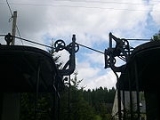
Heberlein brake
Encyclopedia

Locomotive
A locomotive is a railway vehicle that provides the motive power for a train. The word originates from the Latin loco – "from a place", ablative of locus, "place" + Medieval Latin motivus, "causing motion", and is a shortened form of the term locomotive engine, first used in the early 19th...
using a winder. This causes the brake clips to be applied on individual wagons, assisted by a servo
Servomechanism
thumb|right|200px|Industrial servomotorThe grey/green cylinder is the [[Brush |brush-type]] [[DC motor]]. The black section at the bottom contains the [[Epicyclic gearing|planetary]] [[Reduction drive|reduction gear]], and the black object on top of the motor is the optical [[rotary encoder]] for...
system which makes use of the rotation of the axle. The brakes operate automatically if the cable snaps. A typical feature of Heberlein brakes is the clearly visible cable run on top of the wagons, but cables can also be led underneath the wagons, as on the Spreewaldbahn railway line. Heberlein brakes were eventually largely replaced by compressed-air brakes or, sometimes, by vacuum brakes on narrow gauge
Narrow gauge
A narrow gauge railway is a railway that has a track gauge narrower than the of standard gauge railways. Most existing narrow gauge railways have gauges of between and .- Overview :...
railway vehicles.
The Heberlein brake is still permitted as an operating brake on German railways due to its modus operandi (continuous and automatic), especially at the low speeds on narrow gauge lines.
On several narrow gauge railways in Saxony
Saxony
The Free State of Saxony is a landlocked state of Germany, contingent with Brandenburg, Saxony Anhalt, Thuringia, Bavaria, the Czech Republic and Poland. It is the tenth-largest German state in area, with of Germany's sixteen states....
, numerous vehicles with Heberlein systems can still be seen. These include the Lößnitzgrundbahn, Weißeritztalbahn and Rittersgrün narrow gauge museum railway. On the Preßnitztalbahn trains using Heberlein brakes run regularly, several times a year.
Because of the way they operate, there is a longer delay with Heberlein brakes before the brakes take effect when compared with compressed-air or vacuum brakes. As a result, locomotive and train crews have to be given appropriate training and experience these days when using this type of brake in practice.
The Görlitz weight brake (Görlitzer Gewichtsbremse), a form of cable brake, operates in a similar way to the Heberlein brake, but differs markedly in its design details, as does the Schmid continuous spiral-toothed gear brake.

